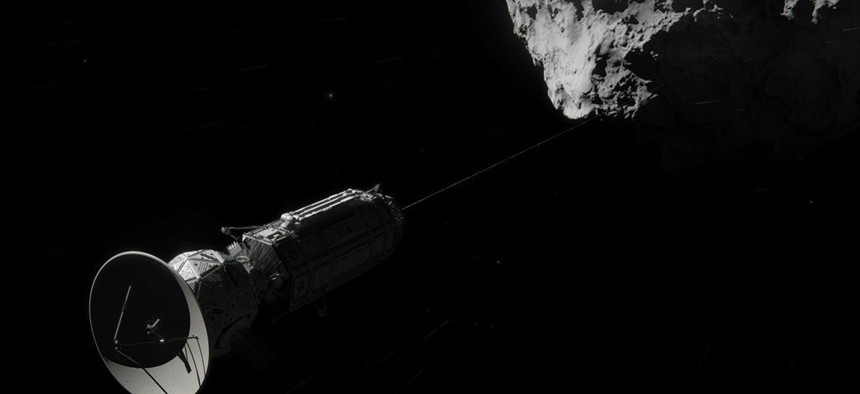
NASA/JPL-Caltech/Cornelius Dammrich
NASA Plans to Hitch Rides on Comets – Using Harpoons and Tethers
The system may one day be used to hitchhike across the solar system.
If this were the creation of some space-obsessed civilian, it would probably be written off as ludicrous. But it’s anything but.
A project currently in development at NASA, inspired by the 1970s science-fiction series The Hitchhiker’s Guide to the Galaxy, aims to create a system in which spacecraft land on comets and asteroids using very strong harpoons attached to very long tethers. Each spacecraft would then untether itself and eject from the celestial body to go on its merry way, having successfully hitched a ride.
“The Comet Hitchhiker concept is literally to hitch rides on comets to tour around the Solar System,” writes Masahiro Ono, the project’s principal investigator, on a NASA web page. “We strongly believe that the Comet Hitchhiker concept will advance the frontier of space exploration to the most exotic worlds in the Solar System.”
The spacecraft first casts a tether—with a harpoon on the end of it—toward the target. NASA says the process is analogous to fishing:
Imagine you’re on a boat on a lake with a fishing pole, and want to catch a big fish. Once the fish bites, you would release more of the line with a moderate tension, rather than holding it tightly. With a long enough line, the boat will eventually catch up with the fish.
Once the spacecraft matches its velocity to the “fish”—the comet or asteroid in this case—it is ready to land by simply reeling in the tether and descending gently. When it’s time to move on to another celestial target, the spacecraft would use the harvested energy to quickly retrieve the tether, which accelerates the spacecraft away from the body.
Apparently, the kinetic energy captured from the comet is enough to send a spacecraft back into space, without ever needing a propellant like rocket fuel. Here’s a NASA graphic, if you’re still a little befuddled:

Ono writes that the system can be used to hitchhike across the Kuiper Belt—a collection of small, icy bodies beyond Neptune, which the New Horizons spacecraft now plans to explore (after having successfully toured Pluto). Comet Hitchhiker could allow spacecrafts to visit five to 10 bodies in a single mission.
This is by no means the only way to land on a comet or asteroid. The European Space Agency landed its Philae lander on a comet last year, but it was a one-way trip, with no intention of ever leaving. (Philae was actually supposed to use a harpoon to anchor itself upon arrival, but it didn’t fire, leading to a rather bumpy landing.)
NASA’s Comet Hitchhiker plan would conceivably be a much cheaper option as well as one designed specifically to, well, hitchhike.
By hitching rides off comets, Ono writes, a spacecraft could reach Pluto’s orbit in 5.5 years (about half the time it took New Horizons to get there). He presented his research at the American Institute of Aeronautics and Astronautics SPACE conference on Sept. 1, and says the next step is to run more simulations and test the system using a mini harpoon and a surface that resembles that of a comet or asteroid.






